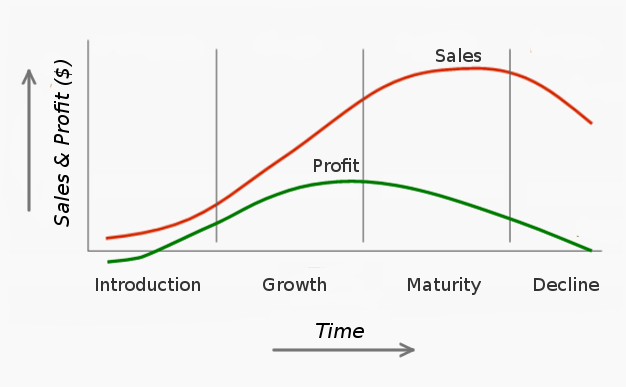Products rarely, if ever, sell well forever. As your product, market, and customers change over time, so should your company’s differentiating and positioning strategy. To better manage a product over it’s lifespan, it’s important for managers and business people to understand the basics of what a product life cycle is.
The Concept of the Product Life Cycle
To say a product has a life cycle is to assert these four things:
- Products have a limited life.
- Product sales pass through distinct stages. Each stage presents different challenges and opportunities to the seller.
- Profits rise and fall at different stages in the product life cycle.
- Products need different business strategies in each stage of their life cycle.
The sales an profitability of most products follow a bell shaped curve over time. Most marketers divide this curve into four stages: introduction, growth, maturity, and decline. You can use the Product Life Cycle concept to analyze product categories (liquor), a product form (white liquor), a product (vodka), as well as a brand (Grey Goose).

Life Cycle Stages
- Introduction: A period of slow sales growth as the product is first introduced to the market. During this stage, profits are low or non-existent because of the costs incurred introducing the product.
- Growth: A period of rapid market acceptance and significant profit improvement.
- Maturity: A period when sales growth slows down because the product has been accepted by most potential buyers. Profits stabilize or decrease because of increased competition.
- Decline: The period when sales drift downwards and profits decrease.
The Pattern Is Not Always Bell-Shaped
Keep in mind that not all products follow a bell-shaped life cycle pattern as shown in the diagram above. Researchers have identified over a dozen different Product Life Cycle patterns. For example, a fashion fad becomes popular quickly, peak early, and decline very fast. Fads don’t usually last long because most of them don’t satisfy a strong need.
Product Life Cycle for Tech Products
Technology products are another interesting and important case. The life cycle curve for technology products tends to be compressed, as described in this BBC video:
Conclusion
The product life cycle stages explain the changes in sales and profitability of products over their lifespan. To improve profitability and market positions, product managers need to use appropriate strategies for each life cycle stage.